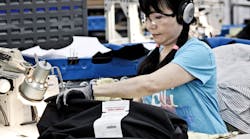If you’re taking the first steps on the journey to building a world-class safety culture, you might take heart in the words of Adam Goldman, vice president of human resources for Safariland LLC. Reflecting on the accomplishments that helped the Ontario, Calif.-based manufacturer of law enforcement gear become one of the 2013 America’s Safest Companies, Goldman admits: “None of it is rocket science.”
“Nothing that we’ve done here has required ridiculous amounts of investment,” Goldman says. “Nothing that we’ve done here has required a complete turnover of staff. Nothing that we’ve done here can’t be replicated anyplace else.”
Founded in 1964, Safariland grew through a slew of acquisitions, and its various brands operated like standalone businesses. In 2008, the company (then a unit of BAE Systems Inc.) launched a reorganization process, with the goal of shifting from “a holding-company mentality” to “a world-class organization,” Goldman explains. That effort included a recalibration of what hitherto had been a disjointed EHS program.
“We always did some work around environmental, health and safety, but it was kind of like ‘Level 1’ work – licenses, permits and registrations,” Goldman says. “We did not have a shared philosophy that was driven from the top down, except to maintain compliance activities.”
That changed in 2008, with the hiring of Patrick Ross – Safariland’s first corporate-level EHS director. Ross says his top priority was to find ways to bring “employees into the loop.” He took the first step by forming a safety committee.
“Then we started an employee-owned safety committee, and then we started to get employees involved with risk assessments,” Ross explains.
Building on those “cornerstones,” as Ross calls them, Ross added more activities to encourage employee involvement, including toolbox training sessions, near-miss investigations, environmental-impact assessments, morning exercises and biannual town-hall meetings.
"I'm a firm believer that any change or culture development has to start with the associates on the floor," Ross says.
Go-Yield-Stop
Perhaps the most effective tool for fostering associate involvement has been the “Go-Yield-Stop” program, which encourages employees to observe and report safe work practices as well as unsafe work practices and “latent” conditions (conditions that could cause injuries) on the plant floor. By participating in the observation program, employees are entered in monthly, quarterly and annual raffles for prizes.
An employee hands out a green ticket when he or she observes a colleague doing something “beyond the call of duty for safety,” Ross explains, and hands out a red ticket when he or she observes a co-worker engaging in an unsafe action. In the latter case, the observer is expected to address the unsafe act with his or her co-worker.
When an associate observes an unsafe condition – such as a leak or a loose piece of machine guarding – he or she gives a yellow ticket to a supervisor or EHS specialist.
“When they identify something that could cause an incident, we go out and we fix it,” Ross explains. “We let them tell us how they think it should be, and we take care of it.”
By the way, Ross notes that red tickets have become a rarity, which is not surprising considering the dramatic improvement in Safariland’s safety metrics. The company’s lost-time injury rate dropped from over 6 in 2008 to zero in 2012.
Uphill Battle at First
Although Ross’s efforts to establish a strong safety culture had the full support of Safariland President Scott O’Brien, it wasn’t easy at first. Ross faced some pushback from plant managers and others in Safariland’s highly tenured workforce, and Goldman describes the early efforts as something akin to “trying to swing a U-turn in a cruise ship.”
The company created some “positive reinforcement,” as Goldman puts it, by tying financial incentives to its safety performance. The scorecard for determining annual bonuses – for plant-floor workers, managers and executives – includes: overall employee participation in safety (each site has a goal of 75 percent associate involvement in EHS activities); employee participation in risk assessments; and participation in near-miss investigations.
“We put our money where our mouth is from that perspective,” Goldman says.
The Go-Yield-Stop program has been so successful, Ross points out, that Safariland plans to add it to the incentive scorecard. “We really push leading indicators,” Ross says.
Ross attributes Safariland’s safety turnaround to “all the elements coming together.” It’s the VPs and other executives taking part in plant-floor safety walks. It’s O’Brien dedicating large chunks of time to safety during quarterly meetings. It’s the company well exceeding its goals for participation in environmental-impact assessments, safety committees, Go-Yield-Stop observations and other safety activities.
In five years, Ross has seen the EHS culture evolve from a check-the-box mentality into an environment where employees are “continuously” looking for safer ways to work and watching out for their co-corkers.
“When we first started risk assessments, [the EHS staff] had to go out and get a team together” and kickstart the process, Ross recalls. “Now we have folks come to us and say, ‘We’re overdue for a risk assessment in this area.’ So employees are driving the forward progress on that.”
